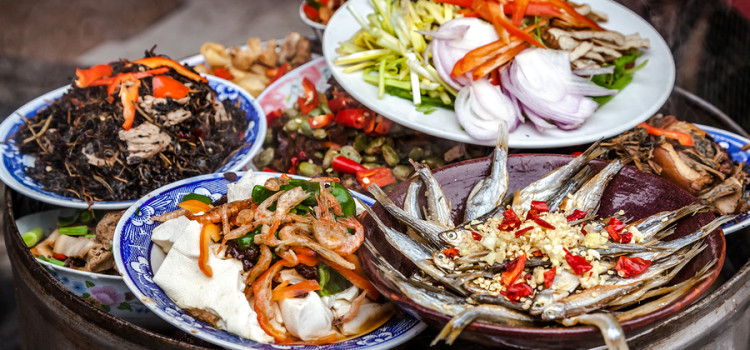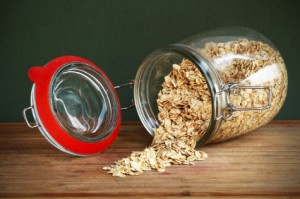

In far too many countries, Chinese food has a not-so-healthy reputation. We mostly only know what we get from many take-out restaurants or shopping mall food courts, which tends to be mystery meats flavored with monosodium glutamate (the dreaded “MSG”) piled on a hefty amount of greasy noodles or refined white rice.
That food, however, would be completely unrecognizable to most people living in China. Chinese “fast food” breaks almost every rule of the traditional Chinese diet, which is actually one of the healthiest in the world.

The Chinese diet has a long, complicated history, based in thousands of years of Chinese medicine.
Chinese Medicine Philosophy
Chinese culture is based on the philosophy of “yin” and “yang”, as well as the “Five Elements.” From medicine and martial arts to dance and cooking, Chinese culture is built on a foundation of balance, harmony, contrast, and adapting to change.
Part of that balance figures into food. Each organ is tied to an element and a taste. For example, bitter is tied to the heart and fire. (Also, sweet: spleen/earth, sour: liver/wood, spicy: lungs/metal, salty: kidneys/water.) In building a healthy meal, all five of these tastes should be incorporated. That is said to keep the body in balance, which in turn protects it from disease.
The Cultural Revolution
In order to understand where the Chinese diet stands today, you have to understand the country’s history. For thousands of years, the concept of balance from Chinese philosophy kept Chinese communities from straying from the traditional diet. There were always periods of famine and periods of wealth, but without much industry or access to western food there was never a question of leaving behind the traditional diets. When food was available, it was prepared according to the recommendations of Chinese medicine.
This started to change in the late 1800s with the influx of western food habits, the principle result of which was the historical change from whole brown rice to polished (refined) white rice. In 1949, widespread famine killed millions in China. There had been famine before, but at the end of this famine there was a dramatic shift in the way people grew and imported food and ate. Cereal consumption shot up in 1952, as did pork and “junk” food consumption. The proportion of energy intake from fat tripled, and by 1982 China saw its first significant rise in the number of overweight people and those stricken with diet-related cancers.
Looking for Wisdom in the Past
Many blame China’s shift into unhealthy eating habits on the availability of western foods. Particularly in cities, the Chinese diet today has shifted towards fats and sodium. Food is steamed, baked, and boiled less frequently than it was in the past, and there is far more snacking and eating outside of the house (an idea that was unheard of before the new millennium).
Much like those who are demanding the Mediterranean diet and the Nordic diet, and very much like Native Americans of late, many Chinese people are now seeking a return to their traditional diet. Though it only fell by the wayside fewer than 70 years ago, we have already seen a decline in the general health of the population. Western eating habits have been picking away at long-held Chinese principles of balance and harmony in the kitchen, and it’s time we all—Chinese and otherwise—took a look at what the traditional Chinese diet has to offer.
How to Keep to the Traditional Chinese Diet:
- Drink green tea
Green tea helps to hold off hunger, aid digestion, and fight free radicals, which cause heart disease and cancer. In China, it’s customary to leave the same leaves in a pot and simply add water when a person wants a second or third cup. That way, they take in less caffeine than they would from several tea bags used one after another, and avoid chemicals involved in tea bag production.
- Give up dairy
Dairy is designed for infants, and ours is the only species that continues to drink milk into adulthood. Instead of relying on dairy for calcium, get it from green leafy vegetables, sesame seeds, and fermented soy curds made with calcium.
- Choose white rice, not brown
Brown rice is white rice with a hull around it, but the nutrients in that hull have poor bioavailability. That means our bodies use up energy breaking them down. That said, the Chinese diet values moderation and balance. Instead of having white rice at all times, try to rotate between all the available grains.
- Don’t count calories
Chinese medicine sees food as nourishment, not potential body fat. Instead of counting calories, the Chinese diet simply aims to include healthy foods. For example, an avocado may have more than 200 more calories than a diet soda. But no one is about to argue that the diet soda is better for you than the avocado! Stop thinking about math, and start thinking about nutrition.
- Eat red meat in moderation
According to Chinese medicine, it’s a mistake to have too much red meat, and not everyone can do without it. Instead of giving up red meat altogether, the Chinese diet advises two ounces twice a week.
- Bring balance to your dishes
According to Chinese medicine, meals should always balance ingredients that are yin (wet and moist) and yang (dry and crisp). Yin foods cool the body, and yang foods heat it up. Another way to think of it is this: yin foods are usually carbohydrates, and yang foods are usually proteins. By cooking a dish that includes both of these (e.g., grain noodles with mung beans), the combination of proteins and carbohydrates can help to stabilize blood sugar and insulin—keys to metabolic health.
- Eat slowly, and stop when you feel full
This might be the hardest part of the Chinese diet, but it’s certainly one of the most important. A major problem with western diets today is the way we have tied eating to guilt. Instead of eating three good meals a day, we might skip breakfast and then give in to a pastry by 10am. We might eat vegetables all week, then binge on potato chips all weekend. The way many of us see food is in extremes, bouncing from hunger to excess every few hours.
The solution, according to the Chinese diet, is to never skip meals. To eat three complete, healthy meals every day, and to eat until you feel that you are full. Of course, there’s a caveat: you have to eat slowly. It takes the brain some time to signal that you feel full, so it’s very easy to overeat without realizing it if you’re in a rush. Sit down, take your time, and appreciate your meals until you know it’s time to stop.
- Serve soup at every meal
Western foods are quite dry, and we make up for it by drinking plenty of water during and between meals. The Chinese diet takes a different approach. Their meals almost always include a soup-based dish, which helps to fill the stomach and control the appetite. If you can get a fermented soup (such as miso), all the better. (https://norvado.com/) Fermented soups are probiotics, which help to release nutrients from the foods you take in.
- Rethink your “mains” and “sides”
In the US, meat is a main dish and vegetables are side dishes. But in China, vegetables are viewed as main courses. When you’re preparing a plate for dinner, try to think about what you’re paying the most attention to. Instead of a plate that is two-thirds meat and one-third vegetables, aim for a plate that is two-thirds vegetables and one-third meat. At the very least, half your meal should consist of vegetables.
- Learn about Chinese medicine
There’s no substitute for a doctor when you’re actually ill, but under most circumstances we can all benefit from learning how natural vegetables, herbs, and spices can keep us healthy. For example, chilies can promote digestion and ginger eases nausea. Whether you believe in these cures or not, at the end of the day it’s just one more reason to make sure you take in plenty of healthy, natural foods.
Keeping the Chinese Diet doesn’t necessarily mean eating Chinese food all the time. In fact, if you aren’t prepared to cook it yourself and don’t have a reliable healthy outside source, you may be much better off avoiding it! You can make your own favorite dishes, whether they come from Mexico or your grandmother in Pennsylvania. The key to the Chinese diet isn’t wonton soup: it’s natural ingredients and balance.
Every time you buy and make something, focus on the unrefined, all-natural version. When you make something starchy, consider adding legumes. The next time you want a snack, boil a cup of green tea. Pile your plate with vegetables, and drink a cup of soup on the side. Strive for balance, whatever that means for you.
You won’t find THESE foods in the traditional Chinese diet!
Sources
- Bussell, J. The Asian Diet. Theasiandiet.com. Retrieved 2016 Feb 1.
- Du, SF. China in the period of transition from scarcity and extensive undernutrition to emerging nutrition-related noncommunicable diseases, 1949–1992. In: Obesity Reviews. Ncbi.nlm.nih.gov. 2014 Jan. Retrieved 2016 Feb 1.
- Hou, Y. Origin and concept of medicine food homology and its application in modern functional foods. In: Food & Function. Ncbi.nlm.nih.gov. 2013 Dec. Retrieved 2016 Feb 1.
- Inn, M. The Chinese Diet: The Path to Harmony and Good Health. Iritaichi.org. Retrieved 2016 Feb 1.
- Use your noodle: The real Chinese diet is so healthy it could solve the West’s obesity crisis. In: Healthy Living. Independent.co.uk. 2008 Jul 22. Retrieved 2016 Feb 1.
- Zhai, FY. Dynamics of the Chinese diet and the role of urbanicity, 1991-2011. In: Obesity Reviews. Ncbi.nlm.nih.gov. 2014 Jan. Retrieved 2016 Feb 1.
Comments 13
Leave a Reply
You must be logged in to post a comment.




I enjoyed this article on Chinese food. As a lifetime dieter, I have always loved Chinese, but have avoided it due to sodium and high starch. It is good to know that even if not eating actual Chinese food, the balance learned from the Chinese diet can be applied here. I learned a long time ago to eat slower for better control. I didn’t realize that the concept was incorporated into the Chinese diet. And the soup … every Chinese restaurant I have visited offers soup before the meal. Interesting. Thanks for the enlightenment.
Can you tell me if eating white bread with tomatoes, cucumber and lettuce is a good sandwich. Or should I avoid sandwiches all together.
Hi, Fiona. That sort of sandwich is fine, but we would prefer that instead of white bread you choose 100% whole grain (wholemeal) bread, sprouted if you can find it.
I started on Monday and I feel the difference already and my husband even noticed. I can’t find the page on free spreads. Can you help.
Hi, eveseeds. That’s great!
You can see the “Free Spreads” list by clicking on the term in your menu, which will bring you to the list.
Can you tell me what exchanges and number of types of foods I need daily for the diet you calculated for me?
Hi, seczzell7. You can see your set of exchange allotments by clicking on “Exchange mode” in the toolbar above your finished menu. Our list of exchanges is here – https://www.trimdownclub.com/exchanges-lists.
I too, have never been able to understand why the healthy banana is the illustration on “Foods to Avoid”. Makes no sense. .
Everywhere I have read before I’m sure bananas are not recommended.
You are definitely saying they are OK to eat.
Stuart
Hi, Stuart. I’m not sure where you saw that bananas are not OK for the average person, but they are highly nutritious, and we recommend them if you don’t need to avoid high-potassium foods. Check out our “Articles” section for various pieces on the topic.
you show a banana as one of the five foods never to eat yet it’s in my menu and has no substitution. Please advise
Hi, Dori. Actually, banana isn’t one of the five foods never to eat – it is highly recommended (we have several articles about it that you can check out). It has no substitution because it is very dense and so counts for either 2 fruits or 1 fruit + 1 starchy carb exchange.
Just hoping this really helps!
I’m not good with technology and I keep having problems viewing this.